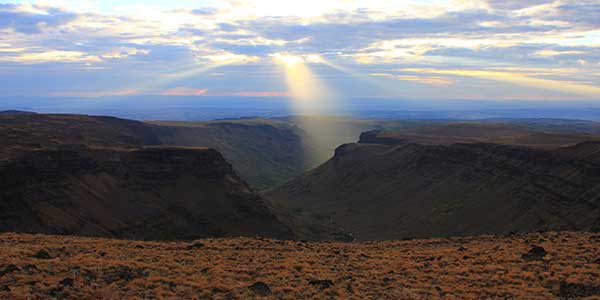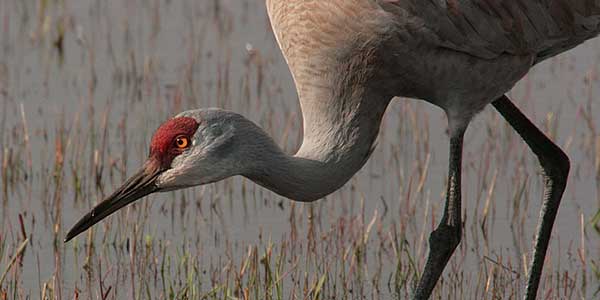Land of the Oregon Trail
Follow pioneer wagon tracks into rugged landscapes of adventure
With its sprawling ranch lands, parched deserts, yawning canyons and serrated mountain ranges, eastern Oregon has more in common with Nevada and Utah than the Pacific Northwest. Miles of scenic byways traverse lands where wagon ruts carved the Oregon Trail, and working cattle ranches, rodeos galore and Western-themed art galleries speak to the region’s epic Wild West history.
The discovery of gold in northeast Oregon’s Blue Mountains in the 1860s gave rise to boom towns such as Umatilla and Baker City, which provide a convenient launching pad for bucket list-worthy natural wonders. These include the snow-capped peaks of the Wallowa Mountains, the foreboding Hells Canyon and the glacier-carved valleys of the Steens Mountain range.
While much of the countryside of this route has been tamed, the stunning landscapes and compelling wilderness will remind you of the challenges faced by the pioneers who traversed the area more than a century ago.

Bureau of Land Management Oregon and Washington
Umatilla
Named for the Native American tribe that first inhabited the region, Umatilla reached its zenith during the gold rush days of the 1860s. Its location on the shores of the Columbia River made it a regional transportation hub, and Umatilla still takes advantage of its riverside location: the abundance of fishing and boating lure active travelers out in the water to explore. Umatilla’s dry, upland habitats and wetland sloughs serve as homes to a rich array of wildlife. The Umatilla National Wildlife Refuge features virtually every habitat iteration within the Columbia Basin, including shrub-steppe, rim rock, riparian and wetlands.
Keen wildlife watchers are rewarded with sightings of long-billed curlews, burrowing owls, sagebrush lizards, river otters, beavers, diving ducks, side-blotch lizards and kangaroo rats. The McNary National Wildlife Refuge is a birdwatcher’s dreamscape. A tapestry of walking paths orbit ponds and sloughs that provide rich habitat for more than 200 bird species, including migrating waterfowl, songbirds, red-tailed, sharp-shinned and Cooper’s hawks, northern harriers, peregrine falcons, and bald and golden eagles. Within the refuge, horseback riding and hiking is permitted on roads and designated trails, and there’s a novice 2-mile self-guided interpretive trail.
Pendleton
Nestled in the shadows of northeastern Oregon’s Blue Mountains, Pendleton revels in its Western heritage. Famed worldwide as the purveyor of Native American blankets and wool-plaid clothing, Pendleton Woolen Mills is the town’s principal tourist calling card. The town’s Washougal Mill leads visitors through the state-of-the-art dye house and illuminates the production process, from spinning and weaving through to the finishing of the distinctive blankets.
As well as playing host to one of the largest and oldest rodeos in the West, several attractions speak to the town’s notorious Wild West history of gambling and prospecting. Entertaining and informative in equal measure, the immensely popular Pendleton Underground Tours take visitors back to the late 19th-century as they explore a subterranean network of opium dens, gambling lairs brothels and bathhouses.
Far and away, the best time to visit Pendleton is mid-September for the raucous Pendleton Round-Up, the mother of all rodeos. Cowboys and cowgirls take center stage for bareback bronc riding, saddle bronc riding, steer roping and tie-down roping. Pendleton’s Main Street is transformed into a series of carnival grounds with parades, Native American powwows, vendors of every ilk and live music. The festival kicks off with the Happy Canyon Night Show, a chronological sweep of Western history, from early Native American tribes to the prairie schooners of the Oregon Trail pioneers.
Baker City
Baker City oozes Wild West historic charm, with an impressive downtown core that preserves American life of the 1800s. A living museum of Victorian architecture, the town boasts more than 100 buildings on the National Register of Historic Places. The iconic Geiser Grand Hotel (built in 1889) marries turn-of-the-century elegance with modern élan, while Baker Heritage Museum, housed in a majestic brick building, spotlights the region’s pioneering, ranching and gold mining history. Also on display: antique furniture and a magnificent rock collection, which includes thunder eggs, glowing phosphorescent rocks and a 950-pound chunk of quartz.
Going by the moniker of Base Camp Baker, the town is an ideal jumping-off point for out adventure. The Hells Canyon Scenic Byway that encircles the Wallowa Mountains intersects with Interstate 84 at Baker City. To the east, Hells Canyon — the deepest river gorge in North America — is a mecca for extreme sports, from world-class whitewater rafting to mountain climbing and wilderness hiking/biking. Amid awe-inspiring canyons teeming with wildlife, prehistoric pictographs, petroglyphs, pit dwellings and 19th-century mining vestiges provide a compelling historical timeline.
While in Baker City, check out the National Historic Oregon Trail Interpretive Center, which uses living history demonstrations, interpretive programs, exhibits and multi-media presentations to tell the story of the arduous journey west.
Utilizing life-size displays, films and live theater presentations, this Center tells the story of Oregon Trail pioneers, explorers, miners and settlers of the frontier west. The 500-acre site includes remnants of the historic Flagstaff Gold Mine, actual ruts carved by pioneer wagons, and magnificent vistas of the historic route.
Several events and programs allow visitors to walk in the shoes of intrepid pioneers. The popular “Wagons Ho! Experience the Oregon Trail” exhibit tests the pioneering skills of participants. Dress up as a settler and see if you’ve got what it takes to pack a prairie schooner with all the supplies and gear needed to make the long trek west.
Visitors can learn the compelling life story of John C. Fremont, a pioneer who journeyed through Central Oregon in 1843. Fremont’s thorough mapping of the area opened the way for travelers on the Oregon Trail and beyond, setting the stage for his 1856 bid for president of the United States of America. The exhibit is developed by the Deschutes Historical Museum in partnership with the Nevada State Museum in Carson City.
Some 45 minutes southeast of Baker City, Farewell Bend State Recreation Area straddles the Oregon/Idaho border on the banks of the Snake River. Here, the Brownlee Reservoir delivers prime fishing, water skiing, boating and wildlife watching opportunities.
Southeast of Baker City, the 1.7-million-acre Malheur National Forest boasts the largest tracts of Ponderosa pine in the nation. The diverse landscapes of the forest include high-desert grasslands, sage and juniper, pine, fir and other tree species. Several alpine lakes and lush meadows lie within the park and are accessible to adventurous hikers.

U.S. Fish and Wildlife Service Headquarters
High Desert Discovery
To the south of the Malheur National Forest is the town of Burns, which is the starting point for the High Desert Discovery Scenic Byway. This stunning route distills the essence of eastern Oregon’s diverse and dramatic landscapes. Here, surreal deserts, majestic mountains, basalt canyons and shimmering lakes dominate the terrain. Traveling south, the High Desert Discovery Scenic Byway crosses 108 miles before ending in the town of Fields.
Burns sits in Harney County, which, at 10,000 square miles, is bigger than some states. Only about 7,000 people call Harney County home, and most of them live in Burns or its neighbor, Hines. Named after Scottish poet Robert Burns, this is wide-open ranching and timber country.
About 25 miles south of Burns, the Narrows is a base camp for the 69-mile Diamond Loop Back Country Byway. This meanders through high desert terrain to the tiny ranching community of Diamond and its century-old Hotel Diamond. The volcanic vents, craters and cones in the area attest to the geological turmoil of its past. The loop also visits the one-time property of land baron Peter French, who built a unique round barn in the 1880s for breaking horses. It’s now the Pete French Round Barn State Heritage Site.
To the east of the Narrows, the wetlands, marshes and lakes of the Malheur National Wildlife Refuge are hailed as one of the Pacific Northwest’s top birdwatching spots, with more than 320 species. Malheur National Wildlife Refuge collects much of the water of the Harney Basin, making it a draw for anglers eager to hook trout.
Further east is the Donner und Blitzen River, named by German Civil War soldiers who marched through the area in a thunderstorm, which made them think of “thunder and lightning.” The waters are revered for their wild trout fisheries. Nearby, Krumbo Reservoir is another desert lake with top-notch fishing.
Continue south to Steens Mountain, almost 10,000 feet high with an east face composed of basalt rock piled up from millions of years of volcanic activity. This recreational mecca includes a series of hot springs scattered around the sprawling mountain. The area’s challenging terrain, comprising some canyons that drop more than 1 mile, has hosted the nationally famous Steens Mountain High Altitude Running Camp.
On the western slopes of Steens Mountain lies the historic community of Frenchglen. Early travelers to Steens Mountain found a meal and a bed at the Frenchglen Hotel, which is now operated as a state heritage site.
Frenchglen is the gateway to a wide array of recreation possibilities in the region, including bicycling, hiking, hunting, ultralight piloting and stargazing. The Alvord Hot Springs provides a relaxing soak for weary visitors, but be prepared to pay a $5 fee. Other hot springs in the area include Borax Lake, Mickey Hot Springs and Willow Creek Hot Springs.
The route continues through the ranchlands of the Catlow Valley before terminating in the small ranching community of Fields. While here, take a table at the Fields Station, known throughout the region for their juicy hamburgers and thick, delectable milkshakes. The area also is a springboard to remarkable fishing, hunting and sightseeing.
From Fields, you can join the 143-mile East Steens Tour Route north for a soul-stirring montage of Oregon’s stunning basin country. The Alvord Desert playa is one of the largest playas in Oregon and is ground zero for motorcycling, ATV riding, land sailing, glider flying and camping. Bring your toys and cut loose.
Just off East Steens Road, a mosaic of small lakes provide sanctuary to a variety of wildlife. Bighorn sheep and the speedy pronghorn antelope (capable of cruising at 60 miles per hour) can be spotted. If you need R&R, there are several hot springs located near the town of Crane.
Just outside of town lie the Crystal Crane Hot Springs, which offers a hot springs pond as well as private bathhouses. Rent an event space to hold a one-of-a-kind get-together at this soothing destination.
Oregon’s Tall Town
Ready to get back to the mountains? Travel west across the desert to the community of Lakeview, touted as the “Tallest Town in Oregon” for its elevation of 4,798 feet. Sitting at the foot of the Warner Mountains, Lakeview boasts a slew of natural wonders that make it a sleeper hit among Oregon tourism destinations.
Check out the Crack in the Ground, a fissure formed between cooling lava flows around 1,100 years ago. At two miles long and 70 feet deep, the chasm entices hikers with a trail that runs along it’s bottom. During hot summer days, this hike can be a welcome respite from the heat, as the temperature within the trench can be as much as 20 degrees below the surface temperature.
More geological wonders await visitors at Derrick Cave, a lava tube 30 feet high, 50 feet wide and a quarter mile long. Located near Crack in the Ground, this subterranean chamber is collapsed in two places. One provides the acess point and the other serves as a “skylight.”
Equally compelling is Devil’s Garden Wilderness study area, which includes two spatter cones known as “the blowouts.” Geological history continues to unfold in the 2,000-year-old Lake Chewaucan Lake Bed.
About a mile north of town, the Old Perpetual Geyser erupts 60 feet every 90 seconds. The geothermal wonder is found near Hunter’s Hot Springs, whose waters are reputed to have healing properties.
For More Information
Oregon National Historic Trail
www.nps.gov/oreg
Oregon Tourism Commission
800-547-7842
www.traveloregon.com







